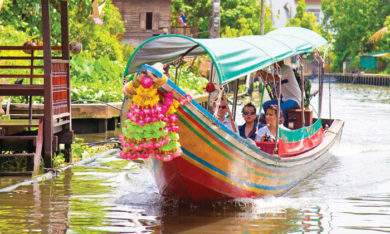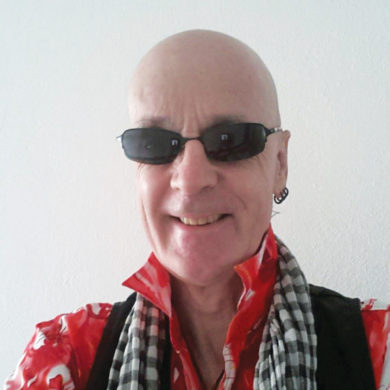
Khlongside conviviality
Bangkok, quite rightly, has gained a reputation for having horrendous traffic jams … but there is an alternative – a long-tailed boat on the khlongs

The first canals (khlongs) in Bangkok were constructed in 1782, around the Rattanakosin district (near Khao San Road), after the destruction of Ayutthaya (then the capital of the Kingdom of Siam) by the invading Burmese, in 1767. Over about the next 120 years, until the dawn of the 20th century, so many canals were built that visiting foreigners named Bangkok as ‘The Venice of the East’. After the year 1900 or so few canals were built, as roads became the priority for a rapidly expanding Bangkok, and some of the canals started to be filled in, or built over. But Bangkok still retains a wealth of canals to explore. Join us on this trip.
On the busy CBD side of the river a very important canal for residents of the Big Mango is Khlong Saen Saeb, which stretches for 18 kilometres through some of the busiest parts of Bangkok. It is dotted with piers every kilometre or so, where commuters can pick up a long-tailed boat (reua hang yao) for a few Baht, and get to their place of work quickly, avoiding the traffic jams and bus or taxi fares. But as a tourist you get to see another side of Bangkok too, as you pass by the wooden houses built on stilts, nestling between golden-roofed temples and high-rise condos or office blocks.
Entire communities live alongside the khlongs, with their families having occupied the same wooden house for several generations. One such little hideaway lies between Sukhumvit Soi 3 and Soi 1. Khun Lek and her husband Somsak have been residents within this close-knit community for more than 40 years, said Khun Lek, “I raised my son and daughters in this house, but now they’re all gone, they want to live in a more modern place with modern conveniences, and with a wifi connection”. But in spite of their rude, wooden self-built houses, the residents of this community are self-effacing and polite. Although so obviously poor, several people sitting on rickety porches outside their home beckoned me inside to sit and eat with them. They may not have much, but what they have they are willing to share with a stranger.
Some of the enterprising people in this community have bought a handcart and sell delicious noodle dishes to the staff and visitors of the nearby Bumrungrad Hospital, one of the city’s most expensive private hospitals. It’s a tasty and filling bargain at about 30 to 40B. I struck up a conversation with one of the doctors eating there during his lunchbreak. He told me that he would much rather enjoy the authentic food they serve him, rather than the bland offerings of Macdonald’s or
KFC, who both have branches within the hospital complex. The doctor also surprised me by letting me in on a secret – most of the highly trained and well-paid doctors that work in Thailand’s private sector donate one or two days of their week to work in the government hospitals, that give free treatment to those in need.
When the Bumrungrad Hospital was being constructed, many people in the surrounding community were worried that the khlong they lived over would be polluted by waste from the hospital, and that their health might be affected. But the hospital built its own waste treatment plant and now the waters of the canal are even cleaner than they were before. A good example of how rich and poor, or the old and the new are able to live together in harmony, with benefits to both. So, from the busy CBD side of the city, let’s continue the journey through some of Bangkok’s khlongs by heading over to Bangkok Yai, on the Thonburi side. As you head up the Chaophraya River towards Khlong Bangkok Yai, you will pass the Santa Cruz church, built by the Portuguese community in 1770. It sits amongst old houses on the river banks and newer buildings further inland, and the reddish dome of this old Catholic church is a prominent landmark on the Chao Phraya River.
After passing this landmark, and turning off the river into Bangkok Yai it might be less than a kilometre before you see a fisherman hauling in his fishing nets, and the houses on the banks of the khlong you pass by are some of the oldest you will see in Bangkok. As you motor up the khlong in your little hang yao boat you will see many more of them parked up on the
banks of the canal, laden with fruit and vegetables for sale. Including some that are selling sweets and drinks, and even cooking hot food in a charcoal fired clay cooking pot. The canal-side dwellers have everything brought to them on their doorstep, they don’t need to make a weekly trip to the market.
While Thonburi is indeed a part of modern Bangkok, and is following the trend towards construction of highrise
developments, the pace is still noticeably slower in Thonburi than it is in bustling Bangkok. After about half an hour travelling along a khlong the city has been left behind, and you can find yourself amongst orchards and reed-covered wharves. There are many small to medium-size temples, most with their own piers, and you really should ask your driver to stop, and take a few of them in – you will find they are not at all touristy and you will have some great photos to show your friends that they will not have seen before.
Khlong Bangkok Yai connects with several smaller canals, and if you are feeling adventurous, and really want to make the most of your day out on the waterways, you can travel all the way by long-tail boat to the most famous floating market, Damnoen Saduak, in Ratchaburi province. Go to Tha Chang pier at Sanam Luang, near the Grand Palace, and negotiate a price for your trip. You will be taken along Bangkok Yai to Khlong Pasi Charoen, and then travel the rest of the way along Khlong Damnoen Saduak, a distance of about 50km. Or you could travel there by road and hire (negotiate, bargain!) a long-tail boat to take you around the floating market once you are there. After your early start to escape the big city for a while, you might find the prospect of a long khlong or bus trip back to the city a little daunting … but no worries, it is not so far away, and there are mini-vans or taxis to take you back to Bangkok in comfort. Whichever way you decide to go or return … pat yourself on the back, you have done something a little different, and ventured off the well-trodden tourist trails. Well done!

Robin Westley Martin is a journalist who has lived in Thailand for 30 years, and has contributed his expertise to many publications. His first position was as News Editor at Business in Thailand, after which he moved on to Hotel and Travel and Kinnaree, where he was Assistant Editor. He has been published in newspapers in Thailand and overseas, such as The Nation and The Sunday Times. Robin currently works on a freelance basis, covering a wide range of genres.


